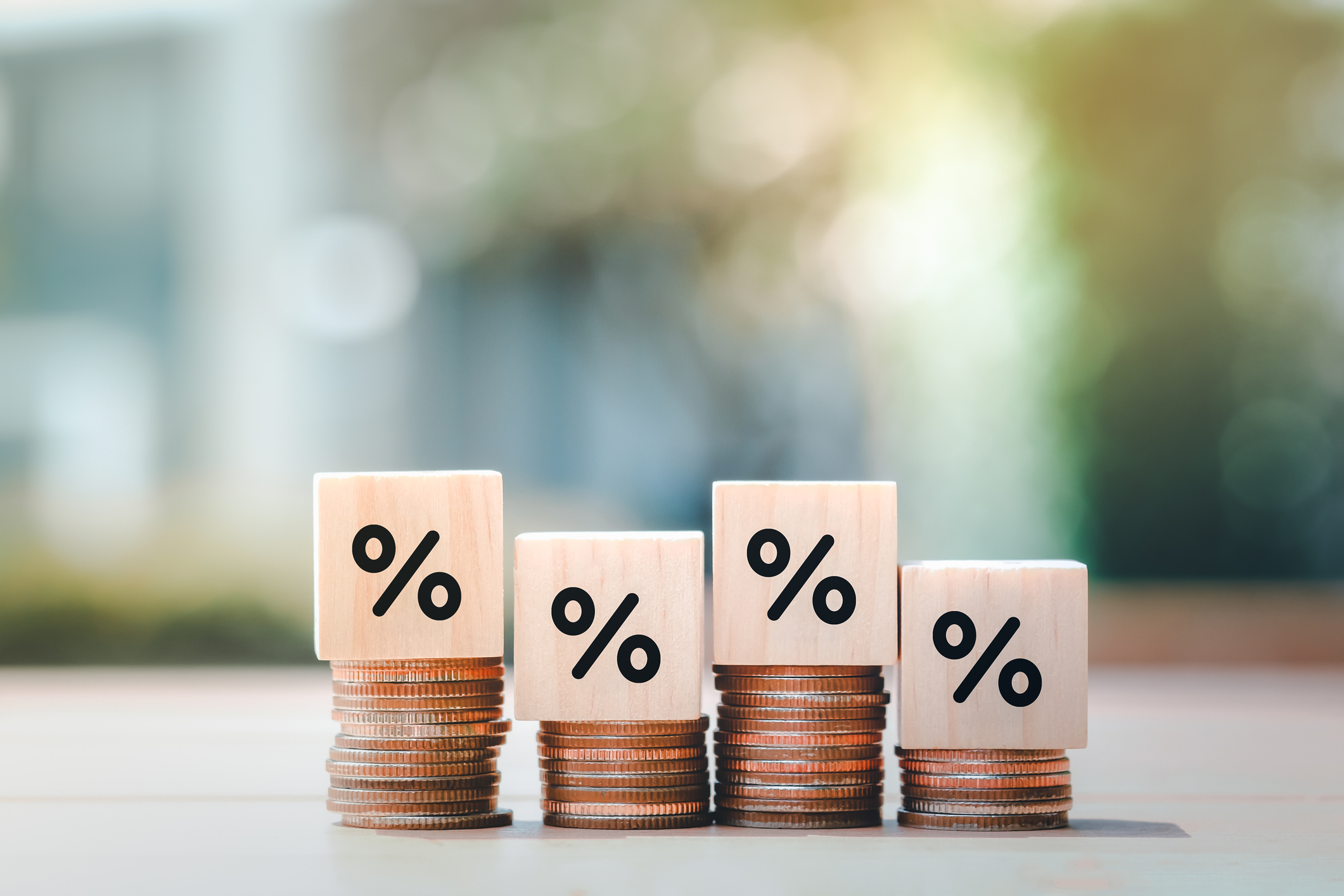35 Ways to Earn Up to 10% on Your Money
Yields are beginning to lift off. We found great deals for every level of risk.

It is hard to believe that just a year ago, the U.S. economy was virtually in free fall, a victim of the pitiless coronavirus pandemic. Unemployment rates soared, yields on Treasuries plunged to record lows, and fear gripped financial markets. Today the environment is nearly the reverse: Economic growth is gaining steam, helped along by trillions of dollars of federal government stimulus; inflation is picking up; yields on Treasuries are rising; and investors are embracing risk again.
Although the economic story is brightening, the same cannot be said for investors seeking income and yield. The S&P 500 index of large-company stocks continues to establish record highs but yields only 1.4%, one of the lowest rates in market history. Interest rates on investment-grade bonds such as Treasuries and high-grade corporate debt are still remarkably low by historical standards and vulnerable to rising rates (bond prices and interest rates move in opposite directions). For example, iShares 20+ Year Treasury Bond, an exchange-traded fund that holds a basket of long-term Treasuries, has lost 12.5% for the year to date, which is six times its yield. Matt Pallai, head of Harbor Funds’ multi-asset solutions, says, “What we see now across the world is that income is one of the most scarce resources.”
With that challenge in mind, we set about searching for income opportunities in eight different asset classes, including bonds, stocks, real estate investment trusts, and master limited partnerships. We can’t do anything about the interest rates available today in categories including municipal and investment-grade bonds, which generally seem to offer low yield with considerable risk, but we believe we have turned up a number of interesting investment opportunities. This guide is intended to help you navigate today’s challenging income landscape.
Before you reach for some attractive yields, it pays to keep a few considerations in mind. You should have a financial plan in place, combined with a strong sense of appropriate long-term portfolio allocations. Everyone’s situation is unique, but generally you should ensure that you have enough cash or cash equivalents on hand to fund six months or a year of living expenses before you invest in high-risk/high-return assets such as stocks and high-yield bonds. Prices, yields and other data are through April 9.

Short-Term Cash Investments: 0-2%
Yields on short-term, fixed-income accounts take their cue from Federal Reserve policy. Therein lies a problem for holders of cash and short-term liquid assets: The Fed is keeping short-term rates near zero today and has telegraphed that it intends to adhere to this policy for at least a couple more years. Therefore, yields available on money market funds, certificates of deposit and short-term Treasuries are microscopic.
The risks: Assuming an inflation rate of 2%, money you hold in cash reserves and liquid assets is losing purchasing power. Yet safe cash equivalents are required for emergency reserves and to meet near-term liabilities, such as taxes or tuition payments. This may be a time to keep cash equivalents to a minimum and, for liabilities more than a year away, to consider options with a bit more yield and slight risk.
How to invest: For an example of the bleak environment for income on short-term accounts, consider Vanguard Federal Money Market (symbol VMFXX, yield 0.01%). Even with Vanguard’s rock-bottom fees, you’re only able to earn one pitiful basis point. So-called high-yield savings accounts and CDs offer a bit more. FDIC-insured Marcus by Goldman Sachs offers a 0.5% annual rate for an online savings account with no minimum balance and 0.65% for a nine-month CD with a $500 minimum balance.
Very-short-term, high-quality bond funds have suddenly become popular for investors seeking to squeeze more basis points out of cash. These funds typically have a duration (a measure of interest-rate sensitivity) of less than 1, which means they fluctuate only marginally with interest-rate movements, and hold short-maturity Treasuries, asset-backed securities and investment-grade corporate bonds. Vanguard Ultra Short-Term Bond (VUBFX, 0.43%) is a good example; exchange-traded funds of the same genre include Pimco Enhanced Short Maturity Active (MINT, $102, 0.33%) and Invesco Ultra Short Duration (GSY, $50, 0.37%). Just remember that these funds have a slight amount of risk, so they’re better matched with liabilities a year or more into the future.
Normally we wouldn’t recommend a fund with a duration of 1.5 for liquid assets, but we’ll make an exception for FPA New Income (FPNIX, 1.65%). This is because of the fund’s superb record of risk management and capital preservation over the years. Steered by Tom Atteberry since 2004 (comanager Abhijeet Patwardhan joined in 2015), New Income has never lost money in any year since its inception in 1984. Fixed-income holdings include asset-backed securities such as auto, credit card and equipment receivables, residential securities, and short-term Treasuries.

Municipal Bonds: 1-2%
Issued by state and local governments in the U.S., muni bonds pay interest that is free from federal taxes and, for bonds issued in your state of residency, free from state and local taxes as well. When large swaths of the economy virtually shut down in the pandemic-ridden spring of 2020, the normally stable muni market suddenly turned volatile. Muni prices slumped (and yields rose) at the same time that Treasuries, benefiting from a panic-driven flight to quality, gained in price. For a window of time, tax-free munis yielded even more than taxable Treasuries and many corporate bonds. But that window soon shut.
The risks: The main risk now may be that muni valuations are extremely rich by several yardsticks, including wide yield discounts compared with Treasuries of the same maturity. Munis staged a powerful recovery over the past year, pressuring yields, as the federal government shoveled fiscal stimulus to state governments, tax collections came in ahead of expectations and investors returned to a somewhat supply-constrained market. Some financial advisers, such as Andy Kapyrin at RegentAtlantic, have even temporarily stopped investing in munis because the math for a higher after-tax return (relative to taxable bonds), especially for short-term munis, doesn’t work even for taxpayers in the highest tax brackets.
How to invest: Munis still have a few things going for them. Defaults are rare—much lower than for investment-grade corporate bonds with the same credit ratings. Munis have very low correlations with stocks and other “risky” assets, which means that they add a diversification benefit to an investment portfolio. They should also benefit from looming tax changes. “Taxes are definitely going up with the new administration, which bodes well for munis,” says David Albrycht, chief investment officer of Newfleet Asset Management.
You can gain exposure to a well-diversified basket of muni bonds by investing in a national muni fund. Fidelity Intermediate Municipal Income (FLTMX, 0.75%) is a member of the Kiplinger 25, the list of our favorite no-load funds. Adjusted for the maximum federal tax rate of 37% plus the 3.8% Medicare surtax on net investment income, the fund’s tax-equivalent yield is 1.27% (or 0.99% for investors in the 24% tax bracket). More than 80% of holdings are rated A or higher. The largest sector is health care; the two biggest state exposures are Texas and Illinois.
Vanguard Intermediate-Term Tax-Exempt (VWITX, 0.84%) is an index fund with 11,000 muni bond holdings, 90% of which are rated A or better. The fund’s low expenses (0.17%) have helped it to easily outperform most actively managed muni-bond funds in most years. The tax-equivalent yield is 1.42% for those who pay at the top federal rate, or 1.11% adjusted for a 24% tax rate. If you seek a higher yield (but with more risk), consider Vanguard High-Yield Tax-Exempt (VWAHX, 1.81%). Despite the name, 80% of this actively managed fund’s holdings are investment grade. The higher yield (a tax-equivalent 3.06% for investors at the top rate; 2.38% for those in the 24% bracket) and risk stem more from the fund’s higher average duration of 6, which implies a roughly 6% portfolio loss if interest rates were to rise by a percentage point.

Investment-Grade Bonds: 1-3%
In normal times, the core of a typical fixed-income portfolio comprises investment-grade bonds issued by the U.S. Treasury, government agencies and corporations that provide income without large fluctuations in bond price. But with this year’s spike in yields and unusually high durations for bond indexes, that formula hasn’t worked recently. “We had years’ worth of volatility in just a few months,” says Eddy Vataru, chief investment officer of Osterweis Total Return. For example, iShares Core U.S. Aggregate Bond, an ETF that tracks the Bloomberg Barclays US Aggregate Bond index, lost 3.4% in the first quarter. Given the fund’s 1.4% yield, it will take an investor nearly 2.5 years to recoup what was lost on principal in those three months.
The risks: Despite the recent rise in interest rates (for example, the yield on 10-year Treasuries rose about 0.75 point in the first quarter), rates are still low by historical standards just as the economy is perking up and inflation expectations are rising. That could translate into higher rates, particularly on intermediate- and long-term investment-grade bonds. (The Fed’s low-interest policy has the most impact on securities up to two years in maturity.) In addition, the corporate-bond yield advantage over Treasuries is unusually narrow. “You need to be super careful in investment-grade bonds now,” says Wayne Plewniak, a bond portfolio manager at Gabelli Funds.
How to invest: Numerous investment strategists, such as Harbor Funds’ Pallai, spot an attractive risk-reward trade-off in securitized products, such as residential and commercial mortgage-backed securities—particularly of the nonagency type. Durations tend to be short and yields relatively high, and mortgage repayments should benefit from rising home prices and consumers who are flush with savings from federal stimulus checks and suppressed consumption.
DoubleLine Total Return Bond (DLTNX, 2.9%), a member of the Kip 25, has nearly all of its money in securitized assets. Comanaged by Jeffrey Gundlach, Andrew Hsu and Ken Shinoda, the fund holds securitized credits such as student and consumer loans, along with a mountain of agency and nonagency residential and commercial mortgages. Jeffrey Sherman, the firm’s deputy chief investment officer, notes that in a time of rising rates, amortizing mortgages enable the fund to reinvest incoming cash flows at higher rates.
At a time when income is meager and interest-rate sensitivity high for Treasuries and investment-grade corporate bonds, many financial advisers turn to actively managed multisector bond funds. In a volatile market, advisers seek tactical portfolio managers with a wide latitude to roam, along with records of sound risk management. Alex Seleznev, portfolio strategist at Councilor, Buchanan & Mitchell, likes the consistency of Baird Core Plus Bond (BCOSX, 1.3%), a diversified intermediate-duration fund managed by a team of eight led by Mary Ellen Stanek, chief investment officer of Baird Advisors. Jeff Porter, of SBSB Financial Advisors, says that Guggenheim Total Return Bond (GIBLX, 1.9%) makes the most of its freedom to roam in the fixed-income market. The fund has handily outrun the Agg consistently over the years.

Real Estate Investment Trusts: 3%
Because REITs are required to distribute at least 90% of their income each year to shareholders, they can offer relatively enticing yields. REITs tend not to move in perfect sync with stocks and bonds, so this asset class offers diversification benefits over time. Plus, REITs provide inflation protection during periods of rising prices (a recent investor focus), due to the hard-asset nature of property and the ability of property owners to pass along rising costs to tenants by jacking up rents.
The risks: Real estate was one of the worst-performing market sectors last year. COVID-induced shutdowns clobbered properties that rely on large assemblies of people—think office buildings, shopping malls and hotels. But the industry’s diversity explains why many commercial REITs fell 20% to 40%, while data center and industrial REITs gained.
How to invest: Jeff Kolitch, manager of Baron Real Estate Income Fund, sees good value in numerous beaten-down commercial and residential REITs, whose assets are selling at values in the public market that represent large discounts to recent private-property transactions. Construction of commercial property plunged in 2020 due to the pandemic, and that has created a supply-demand imbalance.
One of Kolitch’s picks is Douglas Emmett (DEI, $33, 3.4%), a West Coast developer of high-end office and apartment buildings. The Los Angeles–based developer owns high-quality properties in premier, supply-constrained LA neighborhoods, such as Beverly Hills and Westwood. The stock, down 35% last year, trades at a hefty discount to the value of the underlying properties, Kolitch calculates.
John Buckingham, editor of The Prudent Speculator, favors REITs that are aided by secular trends in demographics and technology. Alexandria Real Estate (ARE, $168, 2.6%) is the leading owner-operator of life-science office campuses, where the research and development of pharmaceuticals takes place. Buckingham also likes Digital Realty (DLR, $141, 3.3%), which owns and operates data centers and cloud storage facilities around the world. Alexandria and Digital Realty are not the highest-yielding REITs, but keep in mind that these are growth businesses that are able to boost their distributions by about 6% per year.
Vanguard Real Estate (VNQ, $94, 2.5%) provides low-cost access to a diversified basket of more than 170 securities. The ETF’s largest holdings are American Tower, which owns and operates a vast wireless-communications infrastructure, and Prologis, which owns supply-chain and industrial real estate (including warehouses) worldwide.

High-Yield Bonds: 3-4%
High-yield “junk” bonds are issued by companies with below-investment-grade ratings. For lending to these riskier businesses, investors are compensated with higher yields than investment-grade bonds offer. But today, the sub-5% average yield for “high-yield” bonds is extremely low by historical standards, a function of the current low-interest-rate regime and tight spreads between junk and investment-grade bonds.
But because of their shorter maturities and higher coupons, high-yield bonds have a much lower duration than investment-grade bonds. That means junk bonds are less sensitive to interest rate increases—a serious risk for bond portfolios today. Just note that junk bonds move more in sync with stocks than with Treasuries and likely merit only a limited portion of your fixed-income allocation.
The risks: Usually, the risk of default is a chief consideration. But Ray Kennedy, comanager of Hotchkis & Wiley High Yield Fund, thinks the default rate, which may have been as high as 8% for junk in 2020, could tumble to just 2%, due mostly to a robust economy. “A rising tide really does lift all boats,” he says.
How to invest: Look for nimble risk managers. PGIM High Yield (PHYZX, 4.1%), which focuses on higher-rated junk (that is, bonds rated double- and single-B), has placed in the top performance decile of high-yield funds over the past decade. Vanguard High-Yield Corporate (VWEHX, 3.2%), a Kip 25 fund, has a portfolio that is of higher credit quality than the Bloomberg Barclays U.S. Corporate High Yield index.
Or dampen risk with a lower-duration portfolio. DoubleLine Flexible Income (DLINX, 3.8%) has a duration of just 1.6 and invests in a variety of IOUs, including corporate bonds, bank loans, securitized assets and emerging-markets debt. Osterweis Strategic Income (OSTIX, 2.8%) is remarkably consistent by junk-bond standards. Over two decades the fund suffered losses in just three years, and in only one (2008) was the loss more than 1%. Its focus is high-yield debt approaching maturity (the portfolio’s duration of 1.3 is just 40% of the high-yield index’s duration).

Dividend Stocks: 3-5%
Stocks that pay dividends can play a central income role in a diversified portfolio. Assuming a corporation remains healthy and able to boost distributions each year, dividend growth can match or exceed the rate of inflation. That’s an important consideration for maintaining the purchasing power of a long-term portfolio. Compare that with fixed-income securities, such as Treasuries and corporate bonds, which have coupons that stay the same regardless of movements in consumer prices.
Tom Plumb, president of Plumb Funds, notes that today’s environment is highly unusual in that the dividend yields of blue-chip stocks, such as Johnson & Johnson and Emerson Electric, are higher than the yield available on the same corporations’ debt. (Both stocks are members of the Kiplinger Dividend 15, our favorite dividend stocks.)
The risks: Stocks tend to be much riskier than high-grade bonds in terms of volatility. And high yields on stocks could be a sign of low growth prospects or even distress in the companies. “Don’t blindly buy the yields,” advises Dan Genter, chief executive of RNC Genter Capital Management. “It doesn’t do any good to get 6% in yield if the stock loses 10% in value.” Genter focuses on companies with a consistent history of raising dividends.
How to invest: High-yielders tend to be found among value stocks. Energy prices crashed in pandemic-ridden 2020 but have rebounded this year. Michael Cuggino, manager of the Permanent Portfolio, favors Chevron (CVX, $103, 5.0%), which operates globally, has managed capital allocation well and pays a dividend that is well covered by strong cash flow. The Prudent Speculator’s Buckingham in general avoids investing in regulated utilities, but he makes an exception for Pinnacle West Capital (PNW, $82, 4.1%), a power generator that operates in Arizona, including Phoenix. Much of the appeal is due to the utility’s location in a state with strong growth in population and business investment.
If you seek good growth with a dividend, consider Lockheed Martin (LMT, $386, 2.7%), a Kiplinger Dividend 15 stock. The defense contractor has a huge order backlog, and Plumb believes the firm will benefit from rising defense budgets and a high-tech-weaponry arms race with China and Russia. Big pharma is offering some attractive yields in businesses with growth and strong finances. Pfizer (PFE, $37, 4.3%), for instance, may seem heroic for its lightning-quick development of a leading COVID-19 vaccine, but the stock still trades at a price-earnings ratio of just 11. Bristol-Myers Squibb (BMY, $63, 3.1%) trades at only eight times earnings, which Genter believes undervalues eight new drugs in the pipeline that could generate $25 billion a year in sales.
If you’d rather invest in a basket of dividend stocks, consider Schwab US Dividend Equity (SCHD, $74, 3.1%), a Kiplinger ETF 20 member with an expense ratio of 0.06% that holds about 100 stocks and prioritizes company quality and financial strength in addition to a high yield. Current top holdings are Home Depot and Texas Instruments.

Closed-End Funds: 6-8%
In an industry now dominated by open-end and exchange-traded funds, closed-end funds are a bit unusual. After listing on an exchange and raising capital through an initial public offering, these funds invest the proceeds in stocks, bonds and other financial assets. The fund’s share price fluctuates according to investor demand and can trade at a discount or premium to the per-share value of the underlying assets, or net asset value (NAV).
The risks: Most closed-end funds use borrowed money, or leverage, to purchase portfolio assets. Leverage can augment price returns in bull markets but amplify losses to NAV during bearish periods. Last year was a textbook example of the risk of leverage. John Cole Scott, chief investment officer of Closed-End Fund Advisors, says that the average closed-end fund plummeted 46% from February 19 through March 18, 2020—before recovering smartly.
How to invest: Muni bond funds represent about one-third of the entire closed-end-fund universe. That’s because leverage enables fund managers to boost yields on a relatively low-yielding and safe tax-free bond portfolio. Today’s interest-rate landscape permits managers to borrow cheaply and lend at higher rates to muni borrowers. “We really like the muni market because the cost of borrowing is very attractive now to leverage a high-quality asset,” says Steve O’Neill, a portfolio manager at RiverNorth Capital Management, which is a large manager of closed-end funds.
Scott says a diversified closed-end-fund portfolio could include RiverNorth Managed Duration Muni Income (RMM, $19, 5.8%). The fund trades at a 6% discount to NAV and has a 35% leverage ratio (borrowed money as a percentage of assets), which is about average for a closed-end muni fund. It combines RiverNorth’s tactical investing in closed-end funds (currently 35% of the portfolio) with muni-bond-fund management by money-management firm MacKay Shields (currently 65% of holdings).
For higher income, Scott recommends Nuveen Real Estate Income (JRS, $10, 7.7%), which invests in common and preferred stocks and in debt issued by real estate companies. The fund trades at a 7% discount to NAV and has 28% leverage. Rounding out Scott’s picks are Miller/Howard High Income Equity (HIE, $10, 5.9%), which is replete with energy and financial stocks, sells at an 8% discount and has modest leverage; and Aberdeen Standard Global Infrastructure (ASGI, $20, 6.5%), which holds a global portfolio of infrastructure-related companies (and is permitted to invest up to 20% of assets in private businesses). The fund trades at a 10% discount to NAV and employs no leverage.

Midstream Energy Infrastructure: 5-10%
Midstream companies process, store and transport oil and natural gas. They are positioned between upstream companies (which are involved in energy production) and downstream companies (which produce finished goods). Pipeline companies operate as a kind of toll road, piping oil, natural gas and related products around the country. Two types of businesses operate in this niche: master limited partnerships and C corporations. MLPs pay out most of their income each year to investors and don’t pay corporate taxes. Less than a decade ago, MLPs dominated the industry. But many big players have converted to C-corps, with a broader investor base and simpler, corporate taxation (MLPs issue K-1 forms to investors, which can be a nuisance at tax time). C-corps have benefited from the cut in the corporate tax rate from 35% to 21%.
The risks: Last year was a perfect example of the risk of investing in these nondiversified, rather volatile businesses. Falling energy prices and slumping demand crushed the industry (though operating performance was actually much better than returns suggested). More than half of the MLPs slashed their distributions in 2020 to survive the storm. The industry also faces considerable regulatory risk from the Biden administration.
How to invest: The irony is that the Biden administration’s hostility to building new oil and gas pipelines is bullish for the incumbents. “These assets are critical to the economy,” says MLP specialist Paul Baiocchi, at investment advisory and management firm SS&C ALPS. “If it’s harder to build, it makes existing pipelines more attractive.” Because of this view and a rebound in energy demand, pipeline stocks are up 20% this year.
Simon Lack, manager of the Catalyst MLP & Infrastructure Fund, prefers pipelines involved in cleaner-burning natural gas and related products. One company he likes is Williams Companies (WMB, $24, 7.0%), which handles about 30% of the natural gas in the U.S. and operates a pipeline network from Texas to New York. Canadian firm Enbridge (ENB, $37, 7.1%) moves Canadian oil and gas to the U.S. and is the largest pipeline operator in North America.
Stewart Glickman, energy analyst at CFRA Research, looks for strong businesses in natural gas liquids, which are separated into components with robust underlying demand—such as ethane, used to make plastics. The largest midstream MLP, Enterprise Products Partners (EPD, $23, 7.9%), is a major player in the NGL market. Another MLP with a strong natural gas footprint is Enable Midstream Partners (ENBL, $7, 9.6%).
For a basket of energy-infrastructure businesses, consider Alerian MLP (AMLP, $31, 7.6%). Through a bit of financial engineering, the exchange-traded fund invests only in MLPs but issues a Form 1099 for income to shareholders instead of the annoying Form K-1. Pacer American Energy Independence (USAI, $22, 5.1%) holds a basket of U.S. and Canadian corporate and MLP players. By keeping the MLP weighting to less than 25% of assets, this ETF also avoids the K-1 issue.
Profit and prosper with the best of Kiplinger's advice on investing, taxes, retirement, personal finance and much more. Delivered daily. Enter your email in the box and click Sign Me Up.
Andrew Tanzer is an editorial consultant and investment writer. After working as a journalist for 25 years at magazines that included Forbes and Kiplinger’s Personal Finance, he served as a senior research analyst and investment writer at a leading New York-based financial advisor. Andrew currently writes for several large hedge and mutual funds, private wealth advisors, and a major bank. He earned a BA in East Asian Studies from Wesleyan University, an MS in Journalism from the Columbia Graduate School of Journalism, and holds both CFA and CFP® designations.
-
 Trump Reshapes Foreign Policy
Trump Reshapes Foreign PolicyThe Kiplinger Letter The President starts the new year by putting allies and adversaries on notice.
-
 How to Plan a (Successful) Family Reunion
How to Plan a (Successful) Family ReunionFrom shaping the guest list to building the budget, here's how to design a successful and memorable family reunion.
-
 These Unloved Energy Stocks Are a Bargain
These Unloved Energy Stocks Are a BargainCleaned-up balance sheets and generous dividends make these dirt-cheap energy shares worth a look.
-
 Small Caps Can Only Lead Stocks So High: Stock Market Today
Small Caps Can Only Lead Stocks So High: Stock Market TodayThe main U.S. equity indexes were down for the week, but small-cap stocks look as healthy as they ever have.
-
 Dow Adds 292 Points as Goldman, Nvidia Soar: Stock Market Today
Dow Adds 292 Points as Goldman, Nvidia Soar: Stock Market TodayTaiwan Semiconductor's strong earnings sparked a rally in tech stocks on Thursday, while Goldman Sachs' earnings boosted financials.
-
 Stocks See First Back-to-Back Losses of 2026: Stock Market Today
Stocks See First Back-to-Back Losses of 2026: Stock Market TodayRising geopolitical worries and a continued sell off in financial stocks kept pressure on the main indexes on Wednesday.
-
 Visa Stamps the Dow's 398-Point Slide: Stock Market Today
Visa Stamps the Dow's 398-Point Slide: Stock Market TodayIt's as clear as ever that President Donald Trump and his administration can't (or won't) keep their hands off financial markets.
-
 The December CPI Report Is Out. Here's What It Means for the Fed's Next Move
The December CPI Report Is Out. Here's What It Means for the Fed's Next MoveThe December CPI report came in lighter than expected, but housing costs remain an overhang.
-
 Stocks Climb Wall of Worry to Hit New Highs: Stock Market Today
Stocks Climb Wall of Worry to Hit New Highs: Stock Market TodayThe Trump administration's threats to Fed independence and bank profitability did little to stop the bulls on Monday.
-
 How Worried Should Investors Be About a Jerome Powell Investigation?
How Worried Should Investors Be About a Jerome Powell Investigation?The Justice Department served subpoenas on the Fed about a project to remodel the central bank's historic buildings.
-
 Dow Hits a Record High After December Jobs Report: Stock Market Today
Dow Hits a Record High After December Jobs Report: Stock Market TodayThe S&P 500 also closed the week at its highest level on record, thanks to strong gains for Intel and Vistra.
